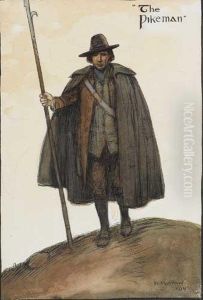Norman Macnamara Morrow Paintings
Norman Macnamara Morrow was a British painter and illustrator born in 1869, known for his genre scenes, portraits, and landscape paintings. Although not as widely recognized as some of his contemporaries, Morrow contributed to the art scene during a time when Britain was experiencing significant changes in its cultural and social landscape.
Morrow studied art at the Belfast School of Art and the Royal Academy Schools in London. His education in these institutions would have placed him in the company of many artists who would go on to shape the direction of British art at the turn of the 20th century. His time in London, in particular, would have exposed him to the vibrant art scene of the city, including the influence of the Pre-Raphaelite Brotherhood and the growing interest in both Impressionism and Post-Impressionism.
Despite the limited information on Morrow's life and career, it is known that he exhibited his work at prominent venues such as the Royal Academy of Arts and the Royal Hibernian Academy. His paintings often depicted everyday life, capturing moments of human experience with a sense of intimacy and emotional resonance. He also worked as an illustrator, which was a common practice among artists of the time to supplement income and gain wider exposure.
Unfortunately, Morrow's career was cut short by his untimely death in 1917, during a period of great turmoil due to World War I. His passing at the age of 48 meant that his artistic legacy was not as fully developed as some of his peers'. Nonetheless, his contributions to British art during his lifetime were part of the rich tapestry of the country's cultural heritage. His works, while perhaps not as extensively documented or celebrated as those of some other artists of his era, still provide a window into the life and times of the late 19th and early 20th centuries.
